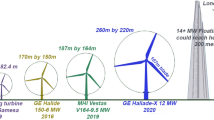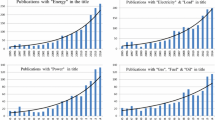Abstract
Wind turbine as a popular growing renewable energy source has found its real location in the modern smart grids more than ever. The useful and efficient deployment of wind turbine in the smart grids depends on accurate modeling of its behavior including the amount of output active power and its continuous variations during the time. Such a complex high-dependent model requires accurate prediction models which can not only follow the wind turbine output power, but can also model its uncertainty effects in the prediction window time. This is mostly triggered due to the extremely instable and casual nature of wind behavior other than the non-linear dependency of wind power on its speed. This paper develops a probabilistic framework for predicting the wind turbine output power based on interval concept. The proposed model can properly predict the wind forecast samples when minimizing the prediction bandwidth and thus increasing the information contained. This is achieved using a lower and upper bound scheme constructed without any prior judgment regarding the uncertainty of prediction distribution. This makes the proposed model so capable of proving realistic intervals which can help the smart grid operator in the optimal scheduling process. To improve the presentation of the proposed model, an efficient search system based on social spider optimization is developed to optimize the prediction model adjusting parameters. The highly trustable and accurate performance of the proposed model is examined using the experimental wind turbine dataset recorded in two different wind turbines in the Australia coastal areas. The results show the promising and accurate prediction results found by the proposed model.




Similar content being viewed by others
References
Amorim A, Cardoso AL, Oyarzabal J, Melo N (2005) Analysis of the connection of a microturbine to a low voltage grid. In 2005 international conference on future power systems, IEEE, Amsterdam, Netherlands, pp 5
Bishop CM (1995) Neural networks for pattern recognition. Oxford University Press, Oxford
Bokde N, Feijóo A, Kulat K (2018) Analysis of differencing and decomposition preprocessing methods for wind speed prediction. Appl Soft Comput 71:926–938
Colak I, Sagiroglu S, Yesilbudak M (2012) Data mining and wind power prediction: a literature review. Renew Energy 46:241–247
Cutler N, Outhred H, MacGill I (2011) Final report on unsw project for aemo to develop a prototype wind power forecasting tool for potential large rapid changes in wind power. In: The centre for energy and environmental markets. UNSW, Reports and Working Papers. http://www.ceem.unsw.edu.au/publications?page=14
de Zordo-Banliat M, Merle X, Dergham G, Cinnella P (2020) Bayesian model-scenario averaged predictions of compressor cascade flows under uncertain turbulence models. Comput Fluids 201:104473
Flores-Agreda D, Cantoni E (2019) Bootstrap estimation of uncertainty in prediction for generalized linear mixed models. Comput Stat Data Anal 130:1–17
Galanis G, Papageorgiou E, Liakatas A (2017) A hybrid Bayesian Kalman filter and applications to numerical wind speed modeling. J Wind Eng Ind Aerodyn 167:1–22
He Y, Li H (2018) Probability density forecasting of wind power using quantile regression neural network and kernel density estimation. Energy Convers Manage 164:374–384
Heskes T (1997) Practical confidence and prediction intervals. In: Mozer TPM, Jordan M (eds) Neural information processing systems, vol 9. MIT Press, Cambridge, pp 176–182
Hoolohan V, Tomlin AS, Cockerill T (2018) Improved near surface wind speed predictions using Gaussian process regression combined with numerical weather predictions and observed meteorological data. Renew Energy 126:1043–1054
Khosravi A, Machado L, Nunes RO (2018) Time-series prediction of wind speed using machine learning algorithms: a case study Osorio wind farm, Brazil. Appl Energy 224:550–566
Khosravi A, Nahavandi S, Creighton D, Jaafar J (2012) Wind farm power uncertainty quantification using a mean-variance estimation method. In: Proceedings of IEEE International Conference on Power System Technology (POWERCON), Auckland, New Zealand, pp 1–6
Li C, Lin S, Xu F, Liu D, Liu J (2018) Short-term wind power prediction based on data mining technology and improved support vector machine method: a case study in Northwest China. J Clean Prod 205:909–922
Liu T, Wei H, Zhang K (2018) Wind power prediction with missing data using Gaussian process regression and multiple imputation. Appl Soft Comput 71:905–916
Mi X, Liu H, Li Y (2019) Wind speed prediction model using singular spectrum analysis, empirical mode decomposition and convolutional support vector machine. Energy Convers Manage 180:196–205
Naik J, Bisoi R, Dash PK (2018b) Prediction interval forecasting of wind speed and wind power using modes decomposition based low rank multi-kernel ridge regression. Renew Energy 129(Part A):357–383
Naik J, Satapathy P, Dash PK (2018a) Short-term wind speed and wind power prediction using hybrid empirical mode decomposition and kernel ridge regression. Appl Soft Comput 70:1167–1188
Ouyang T, Zha X, Qin L (2017) A combined multivariate model for wind power prediction. Energy Convers Manage 144:361–373
Robinson GK, Jones LP (1987) Approximations for prediction error variances. J Dairy Sci 70(8):1623–1632
Saleh AE, Moustafa MS, Abo-Al-Ez KM, Abdullah AA (2016) A hybrid neuro-fuzzy power prediction system for wind energy generation. Int J Electr Power Energy Syst 74:384–395
Shihabudheen KV, Pillai GN (2018) Recent advances in neuro-fuzzy system: a survey. Knowl Based Syst 152:136–162
Torres-Barrán A, Alonso Á, Dorronsoro JR (2019) Regression tree ensembles for wind energy and solar radiation prediction. Neurocomputing 326–327:151–160
Vera-Tudela L, Kühn M (2017) Analysing wind turbine fatigue load prediction: the impact of wind farm flow conditions. Renew Energy 107:352–360
Yan J, Ouyang T (2019) Advanced wind power prediction based on data-driven error correction. Energy Convers Manage 180:302–311
Author information
Authors and Affiliations
Corresponding author
Rights and permissions
About this article
Cite this article
Etemadi, M., Abdollahi, A., Rashidinejad, M. et al. Wind Turbine Output Power Prediction in a Probabilistic Framework Based on Fuzzy Intervals. Iran J Sci Technol Trans Electr Eng 45, 131–139 (2021). https://doi.org/10.1007/s40998-020-00359-9
Received:
Accepted:
Published:
Issue Date:
DOI: https://doi.org/10.1007/s40998-020-00359-9




